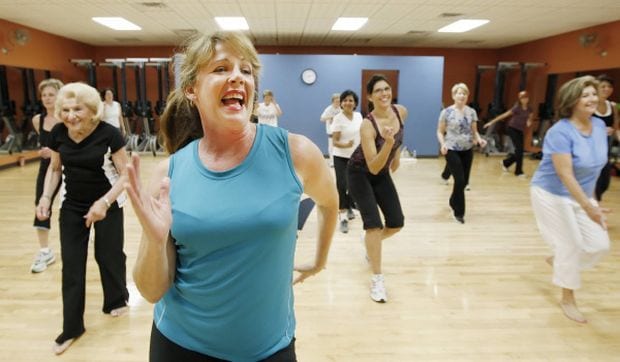Journalist Leslie Garcia Barker interviewed SMU psychologist Dr. Jasper Smits for an article on exercise in the Dallas Morning News. The August 26 article, “Get back into shape by teaming up with a workout group,” quotes Smits, an associate professor of psychology, on the benefits of a buddy system for motivating people to exercise.
Smits co-wrote with psychologist Michael Otto a new book to help people get regular physical activity, “Exercise for Mood and Anxiety: Proven Strategies for Overcoming Depression and Improving Well-Being” (Oxford University Press; $17.95).
In his most recent published research, Smits reported findings that people with an intense fear of the nausea, racing heart, dizziness, stomachaches and shortness of breath that accompany panic — known as “high anxiety sensitivity” — reacted with less anxiety to a panic-inducing stressor if they had been engaging in high levels of physical activity.
“Anxiety sensitivity is an established risk factor for the development of panic and related disorders,” says SmitsJasper Smits, lead author on the research. “This study suggests that this risk factor may be less influential among persons who routinely engage in high levels of physical activity.”
Read the full story (Dallas Morning News subscription required).
EXCERPT:
By Leslie Barker Garcia
Dallas Morning NewsThe first time Lisa Vega attempted the swimming part of a triathlon, the waves were so high she climbed into the rescue kayak. The second time, she ran into the lake, had a panic attack and ran back to shore. The third, she rolled onto her back in the water screaming, “I’m drowning!”
People told her to try another hobby. Instead, she joined Tri Junkies. Without the support of this training group, she says, her journey to successful triathlons — including an Ironman — would have been “a lonely, lonely road.”
“I’ve never in my whole life, as nerdy as this sounds, really been part of anything that I really, really felt this good about,” says Vega, 42, a juvenile probation officer in Fort Worth. “I can’t even explain it. It’s natural, it’s comfortable, and it’s fun.”
Eleven years ago, Joany McCrossen and her niece joined a marathon-training class at Luke???s Locker. McCrossen subsequently completed that White Rock marathon and two others, plus a dozen or so half-marathons.
“Without the class,” says McCrossen, 54, who now coaches for Luke’s, “I would have lost motivation long ago.”
At the Jewish Community Center, group fitness director Terri Arends stresses to her instructors the importance of developing “connection, camaraderie and cohesiveness” in their classes.
“Those elements are so powerful — a powerful and positive drug,” Arends says.
Anyone who has belonged to a group, or even exercised on a regular basis with a partner, knows this firsthand. You count on each other, you look out for each other; your workouts just aren???t the same alone. Participants return week after week, season after season, to training sessions at running stores and workouts with running groups; to yoga and boot-camp and water-exercise classes. They crave the camaraderie, the feeling of belonging.
These friends see them through some of the most physically — and sometimes emotionally — challenging times of their lives.
When McCrossen’s husband, Mac, learned he had cancer earlier this year, her running group brought meals, emailed supportive messages and listened to her concerns and frustrations during their workouts. Members of one particular JCC class, led by Brenda Gardner, have been together “through weddings, deaths, newborn babies, multiple sclerosis and cancer,” Arends says.
Jennifer Kimble, training-class coordinator for Run On, encourages camaraderie among group members, suggesting they meet for dinner or for happy hour in addition to running together.
“They’re your cheering squad,” she says. “They’ll get you through long training runs. Some of my best friends are my running buddies.”
Arends, who titled her master’s thesis “Treadmills Are Non-Conversationalists: Group Exercise Programming Speaks,” says that human element is irreplaceable.
She cites a study at Harvard University of two sections of exercisers — one that worked out as a group, the other solo. Those who worked as a group “had more benefits as far as fitness levels and endurance,” she says. “Their caloric expenditure was higher.”
Jasper Smits is a Southern Methodist University psychologist who studies exercise and its effect on anxiety and depression. “Working out in groups can help increase social support, and that acts as a buffer to many stressors,” says Smits, who co-wrote with psychologist Michael Otto, Exercise for Mood and Anxiety: Proven Strategies for Overcoming Depression and Improving Well-Being (Oxford University Press; $17.95).
“Once you get people to exercise in a group, a buddy system develops. They feel they’re held accountable by others; they’re in this together. Not showing up comes with a cost, and that’s letting someone down.”
Read the full story (Dallas Morning News subscription required).
SMU is a nationally ranked private university in Dallas founded 100 years ago. Today, SMU enrolls nearly 11,000 students who benefit from the academic opportunities and international reach of seven degree-granting schools. For more information see www.smu.edu.
SMU has an uplink facility located on campus for live TV, radio, or online interviews. To speak with an SMU expert or book an SMU guest in the studio, call SMU News & Communications at 214-768-7650.











